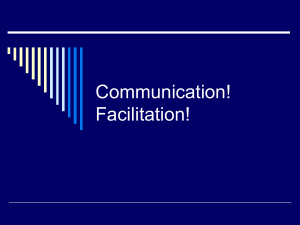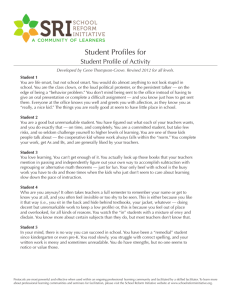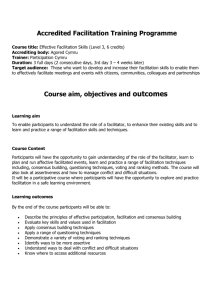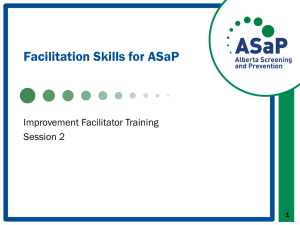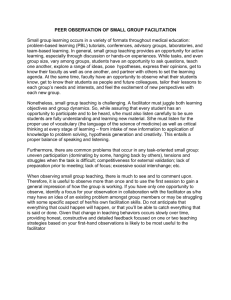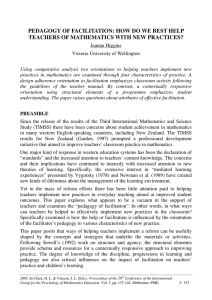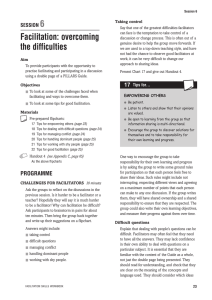Pre Meeting Planning and Meeting Facilitation
advertisement
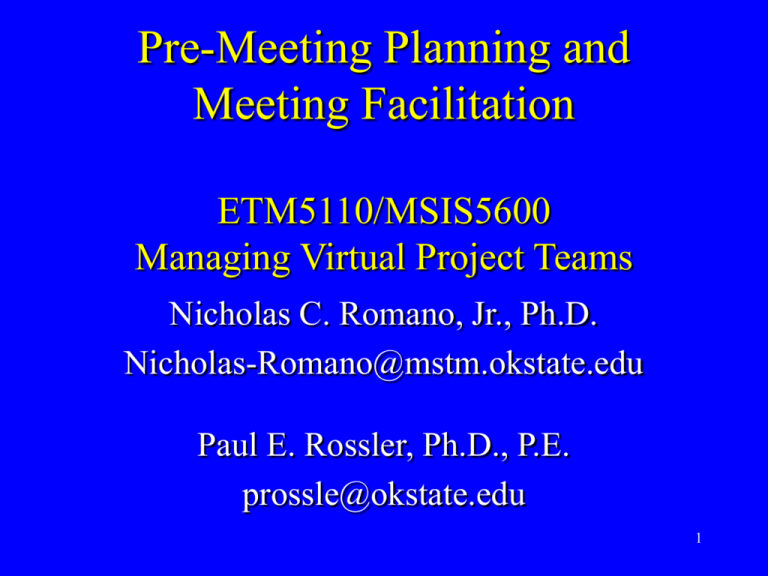
Pre-Meeting Planning and Meeting Facilitation ETM5110/MSIS5600 Managing Virtual Project Teams Nicholas C. Romano, Jr., Ph.D. Nicholas-Romano@mstm.okstate.edu Paul E. Rossler, Ph.D., P.E. prossle@okstate.edu 1 Overview • What things should be considered in planning a virtual team meeting? • How does facilitation work in a virtual setting? • What are the key facilitator roles and behaviors? 2 • What tendencies do virtual teams exhibit during meetings? • What can be done to increase the probability of good meeting outcomes? 3 Four roles relevant to all virtual meetings • Owner – defines meeting objectives and outcomes • Participant – prepare for meeting and take active responsibility for involvement • Facilitator – conducts the meeting process • Technology – enables team members to meet and accomplish tasks 4 All virtual meetings require three activities • • • Selecting the appropriate technology and type of interaction (synchronous, asynchronous) Planning for people issues, scheduling the meeting, and dealing with meeting logistics Developing an effective agenda and facilitating the effective use of technology 5 Meeting purposes: Almost 2/3 involve complex group processes 29% Reconcile conflict 26% Reach group decision or judgement 11% Solve a Problem 11% Ensure that everyone understands 5% 4% 4% 2% Facilitate staff communicaiton Gain support for a program Explore new ideas and concepts Accept Reports 2% Demonstrate a project or system 0% 10% 20% 30% 40% 50% 60% (Monge, P. R., McSween, C., & Wyer, J. 1989) 6 Audio Technology • Advantages – in place – easy to use – cheap • Disadvantages – low media richness – primarily “same time” – less useful for large groups 7 Video Technology • Advantages – personal – fulfills participant expectations – high media richness • Disadvantages – not universally available – expensive/lacking standards – potential for cultural confusion 8 Data Technology • Advantages – widely available – more time independent – very cheap • Disadvantages – impersonal – low media richness – requires extended support 9 GroupSystems • Integration of – – – – Collaborative Technology Attention Dynamics Knowledge Management Customized Repeatable Processes 10 Tech. Mtg. Information Discussion/ Sharing Brainstorming Decisionmaking Productproduction Voice mail Audio conf. E-mail Bulletin board Real-time data conf., no a, v Video conf. w/o shared docs Real-time data conf. w/ a, v, t, g Electronic meeting system Collaborative writing w/ a, v Based on Duarte and Snyder, 2001 11 Team Processes Idea Generation Idea Organization Idea Evaluation and Prioritization Idea Exploration Idea Development and Exposition GSS Tools Brainstorming Topic Commenter Idea Organizer Categorizer Group Outliner Group Matrix Alternative Evaluator Vote Stake Holder Analysis Assumption Surfacing Group Writer Team Graphics Screen Prototyper12 Other Tools Activity Modeler Survey Alternative Analysis Vote Categorizer Outliner Topic Commenter Electronic Brainstorming Collaborative Technology Uses Data Standardization Logical Data Modeling Physical Data Modeling & Population Legacy System Analysis Migration Systems Identification Functional Requirements Definition Functional Feedback on Prototype Systems Business Re-engineering/Modeling Strategic Planning Proposals (DEIS II, TASC, CIM Tools, SBPR) Division (SED) Logistics Functional User Conferences & Demos 13 Guidelines for who to invite to meetings • Relevant experience • Must be in on decision • Are crucial to implementation • Most affected by the problem addressed • Responsible to resolve or implement decision • Direct responsibility and authority over topic of discussion • Enough knowledge to contribute meaningfully • Information unavailable elsewhere Summarized in Romano, N.C. and J.F. Nunamaker. Meeting analysis: Findings from research and practice. In Proceedings of 34th Hawaii International Conference on System Sciences. 2001: 14 IEEE. Optimal traditional meeting sizes Meeting Type Maximum # Participants Comments Problem solving 5 Decision making 5 Problem identification 10 More may bog down process Training seminar 15 Especially hands on Informational 30 To promote interaction Review or presentation 30 Motivational No limit Source: 3M Meeting Management Team and J. Drew, Mastering meetings: Discovering the hidden potential of effective business meetings. 1994, New York: McGraw-Hill. 15 Developing an agenda Handle before meeting List potential topics Define goal for each Handle during meeting Prioritize topics and specify success for each Handle after meeting Based on Kaner, S., Facilitator's Guide to Participatory Decision-Making. 1996, Gabriola Island, British Columbia: New Society Publishers. 16 Example meeting planning format Agenda Item Duarte and Snyder, 2001 Process Technology Facilitation Selected Goals 17 Building the agenda 18 Deciding participant privileges 19 Example virtual team meeting agenda 20 Factors that influence meeting effectiveness • • • • Ability to recall what was said Opportunity to contribute Social status Motivation to participate 21 Relationship between meeting factors and facilitation Factors that Influence Meeting Effectiveness Facilitator Tasks Ability to recall what was Help people find and said remember information Opportunity to contribute Provide opportunity for people to contribute Social status Reduce social pressure that limits participation Motivation to participate Increase motivation to participate 22 Source of facilitation lies on a continuum One or more people Embedded in software (Source: Doug Vogel) 23 A variety of problems lead to unproductive meetings • • • • • Pace Poor meeting design Poor focus Lack of closure Poor process Research findings summarized in Bostrom, R.P., R. Anson, and V.K. Clawson, Group facilitation and group support systems, in Group Support Systems, L.M. Jessup and J.S. Valacich, Editors. 1993, MacMillan Publishing: New York. p. 14624 168. Interventions that improve group processes and outcomes 1. Applying Structured Procedures – – – – – providing instructions to group members extending problem formulation extending idea generation separating idea generation from evaluation delaying solution adoption Research findings summarized in Bostrom, R.P., R. Anson, and V.K. Clawson, Group facilitation and group support systems, in Group Support Systems, L.M. Jessup and J.S. Valacich, Editors. 1993, MacMillan Publishing: New York. p. 14625 168. 2. Encouraging Effective Task Behaviors – – – – discussing task procedures applying explicit criteria using factual information maintaining focus on task goals 26 3. Encouraging Effective Relational Behaviors – – – – – encouraging broad participation and influence managing conflict constructively emphasizing consensus acceptance over majority votes applying active listening techniques discussing interpersonal processes 27 4. Training – – training group members and/or leaders training external facilitators 28 Facilitator behaviors • • • • Recognizing stages of group process Providing motivation Establishing a model of behavior Managing group creativity, anxiety, and conflict Source: Hayne, S.C., The facilitators perspective on meetings and implications for group support systems design. The DATA BASE for Advances in Information Systems, 1999. 30(3, 4): p. 72-90 29 • Maintaining awareness of own feelings as an indicator • Demonstrating flexibility 30 Facilitator interventions • • • • • Planning the meeting Observing communication patterns Determining levels of consensus Creating situations conducive to learning Synthesizing information and building cognitive maps (categories) (Source: Hayne) 31 • • • • Recognizing implicit vs. explicit decisions Detecting variance from structures Confronting the group regarding its process Providing structure to focus group limits and boundaries • Intervening when appropriate at level of group instead of individual • Providing closure 32 Facilitator roles • Ensuring members identify and maintain discussion focus and a procedure for that focus • Ensuring everyone has an opportunity to contribute to the discussion and decisions regarding focus, procedures and decision issues • Understanding group values and providing new values in the process • Sensitivity to time management (Source: Hayne) 33 Some techniques • • • • Auditing team commitment Nominal group technique Baby and bathwater technique Multi-voting 34 Auditing team commitment Not Urgent Demands Immediate Attention Solvability Beyond Our Control Can Solve Ourselves Scope Easily Solved Requires Extensive Effort AccountNot Individually Accountable Fully ability Accountable Feasibility Won’t Work Will Definitely Work Criticality 35 Nominal group technique for generating/prioritizing ideas • • • • Silent generation Round robin listing Clarification (modification, grouping) Voting and ranking (vote score, number of votes) – 7 = most important, 1 = least important • Discussion and action planning 36 Baby and bathwater technique for managing disagreement Person A’s Viewpoint Person B’s Viewpoint Points of Agreement Points of Disagreement 37 Multi-voting for sorting out strongly held positions • The same idea can look different depending on the criterion used – Can cast votes based on one or several criteria – Can cast all votes for one or several ideas 38 Summary • Four roles must be played in virtual team meetings (owner, participant, facilitator, technology) • All virtual team meetings require selecting the right technology, developing an agenda, and facilitating that technologies use • Structure, process, and facilitation influence meeting outcomes 39


